
Bloomsbury is a district in the West End of London, part of the London Borough of Camden in England. It is considered a fashionable residential area, and is the location of numerous cultural, intellectual, and educational institutions. Bloomsbury is home of the British Museum, the largest museum in the United Kingdom, and several educational institutions, including University College London and a number of other colleges and institutes of the University of London as well as its central headquarters, the New College of the Humanities, the University of Law, the Royal Academy of Dramatic Art, the British Medical Association and many others. Bloomsbury is an intellectual and literary hub for London, as home of world-known Bloomsbury Publishing, publishers of the Harry Potter series, and namesake of the Bloomsbury Group, a group of British intellectuals which included author Virginia Woolf, biographer Lytton Strachey, and economist John Maynard Keynes.

The Royal Academy of Dramatic Art is a drama school in London, England, that provides vocational conservatoire training for theatre, film, television, and radio. It is based in the Bloomsbury area of Central London, close to the Senate House complex of the University of London and is a founding member of the Federation of Drama Schools.
Somers Town is an inner-city district in North West London. It has been strongly influenced by the three mainline north London railway termini: Euston (1838), St Pancras (1868) and King's Cross (1852), together with the Midland Railway Somers Town Goods Depot (1887) next to St Pancras, where the British Library now stands. It was named after Charles Cocks, 1st Baron Somers (1725–1806). The area was originally granted by William III to John Somers (1651–1716), Lord Chancellor and Baron Somers of Evesham.

Goodge Street is a London Underground station on Tottenham Court Road in Fitzrovia, in the London Borough of Camden. It is on the Northern line's Charing Cross branch between Warren Street and Tottenham Court Road stations, and is in Travelcard Zone 1.
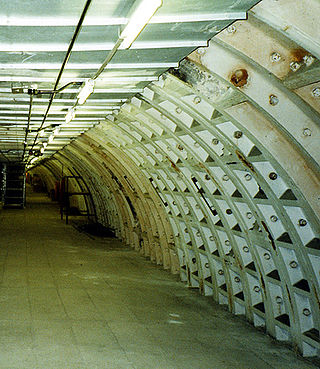
The London deep-level shelters are eight deep-level air-raid shelters that were built under London Underground stations during World War II.

Russell Square is a large garden square in Bloomsbury, in the London Borough of Camden, built predominantly by the firm of James Burton. It is near the University of London's main buildings and the British Museum. Almost exactly square, to the north is Woburn Place and to the south-east is Southampton Row. Russell Square tube station sits to the north-east.

Gordon Square is a public park square in Bloomsbury, London, England. It is part of the Bedford Estate and was designed as one of a pair with the nearby Tavistock Square. It is owned by the University of London.

RADA Studios is a theatrical venue in Chenies Street in Bloomsbury, just to the east of Tottenham Court Road in the West End of London. Owned by the Royal Academy of Dramatic Art (RADA), the building contains rehearsal rooms, meeting rooms, and the 200-seat Studio Theatre.
A drill hall is a building where soldiers practice and perform military drills.
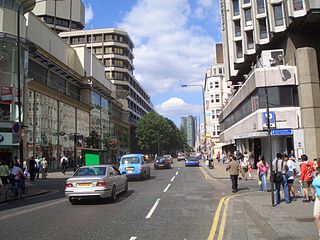
The A400 road is an A road in London that runs from Charing Cross to Archway in North London. It passes some of London's most famous landmarks.

John McKean Brydon was a Scottish architect who developed a practice in designing public buildings, particularly hospitals, in London. He designed the St Peter's Hospital in Henrietta Street, Covent Garden (1880–84), the Hospital for Women in Euston Road, Chelsea Public Library (1890), and the London School of Medicine for Women in Huntley Street (1896). He also designed the Old Vestry Hall at the rear of the Chelsea Town Hall on King's Road, as well as the Government Offices Great George Street, which today house the Treasury, HM Revenues and Customs and part of the Cabinet Office.
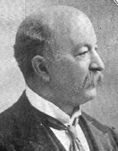
Samuel Knight (1834–1911) was a British architect practising from Cornhill Chambers, 62 Cornhill, London EC and later 175 and 176 Temple Chambers, Tudor Street, London EC.
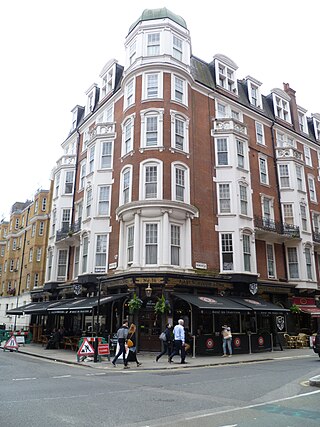
Huntley Street is a street in Bloomsbury, London, known for its close association with University College Hospital.

Ridgmount Street is a street in Bloomsbury, London.
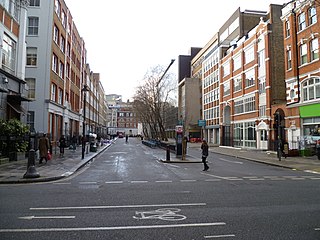
Alfred Place is a street in Bloomsbury, London, running between Chenies Street and Store Street.

Ridgmount Gardens is a street in Bloomsbury, London, that runs from Torrington Place in the north to Chenies Street in the south. It runs parallel with Huntley Street and Gower Street and is continued by Ridgmount Place in the south.

Torrington Place is a street in London that runs between Tottenham Court Road in the West and Byng Place in the East. It is crossed by Huntley Street and Gower Street. Chenies Mews joins it on the north side and is continued by Ridgmount Gardens on the south side.

Store Street is a street in Bloomsbury, London.
The St Giles's and St George's Bloomsbury Rifle Volunteer Corps, more familiarly known as the Bloomsbury Rifles, was a Volunteer unit of the British Army in London from 1803 to 1814 and from 1860 until 1908.
This is a list of the etymology of street names in the London district of Bloomsbury. The following utilises the generally accepted boundaries of Bloomsbury viz. Euston Road to the north, Gray's Inn Road to the east, New Oxford Street, High Holborn, Southampton Row and Theobald's Road to the south and Tottenham Court Road to the west.





















